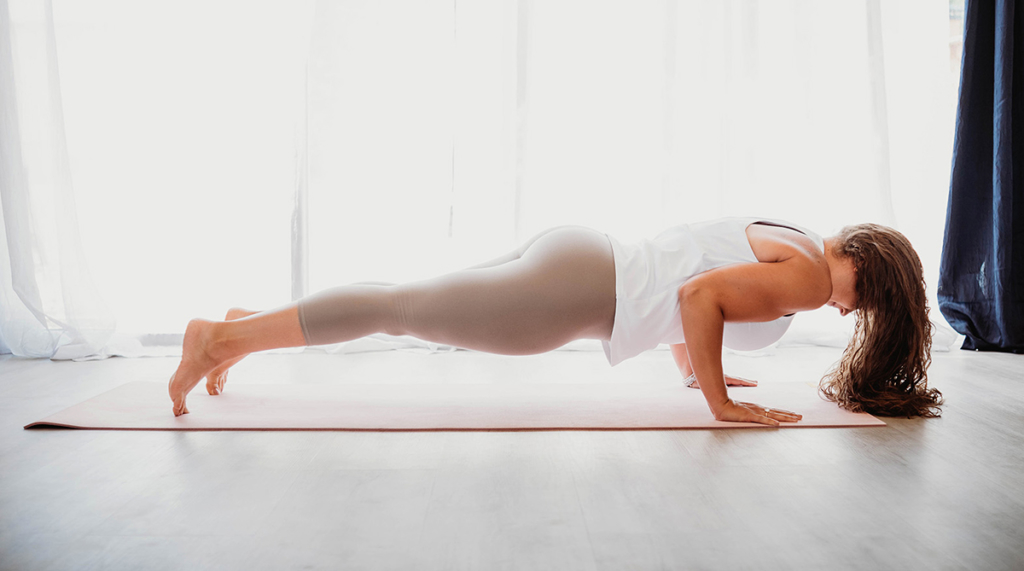
I remember the first time I was able to hold myself up in Chaturanga Dandasana (Four-Limbed Staff Pose). After spending a year struggling with lifting my body off the floor, it was truly thrilling. Later on, I can remember being amazed that I could make it through 108 jump-through Surya Namaskars (Sun Salutations) without crashing and burning.
Now, almost 40 years later, I still practice Chaturanga, but I’m much more focused on quality than quantity.
Chaturanga Dandasana and Your Wrists
The thrill of Chaturanga Dandasana does not come without possible pitfalls. Chronic wrist pain has emerged as a common yoga-related injury. Chaturanga requires that our wrists support a significant percentage our body weight while in full extension. This puts a lot of pressure on the delicate ligaments that are meant to stabilize the joint, and can overstretch them.
But Chaturanga is not the sole culprit. The ubiquitous Chaturanga-Urdhva Mukha Svanasana (Upward Facing Dog Pose)-Adho Mukha Svanasana (Downward Facing Dog Pose) sequence—often practiced 20-30 times in a single practice—can also over-stress our wrists and hands. It’s not that performing this sequence is itself problematic. The problem comes with repetition. In addition, the vinyasa pace is too fast for us to be aware of how we’re performing each pose.
Your Complex and Delicate Wrists
Our wrists are quite complicated. The wrist joints contain 13 small bones and a web of ligaments to keep the joints stable. The delicate configuration of our hands and wrists make them suitable for fine movement. While our wrists can bear our body weight, that’s not really what they do best. So when we call upon them to bear a lot of weight repeatedly in a sequence of poses, we might be asking too much.
How we practice is also important. An article in Yoga Journal, by Ray Long, MD, states:
“ … misalignments in bones, ligaments, and muscles during weight-bearing poses are bound to happen, which can trigger wrist pain and two common conditions in particular. The first, called ulno-carpal abutment syndrome, indicates pressure where the ulna meets the carpal bones on the little-finger side of the wrist. This may occur if the ulna bone has an unusual shape—something just a small percentage of us are born with—or if the wrist is repeatedly turned out toward the little finger in weight-bearing poses like Downward-Facing Dog.
“The second syndrome, tendonitis, is characterized by tendon inflammation, often due to misalignment and weight transfer in poses such as Chaturanga Dandasana, where the wrist joint is in full extension. Chronic wrist injury is also common in yogis with relaxed or hyper-mobile ligaments, which can cause inflammation, pain, and ultimately arthritis.”
How to Practice a Pain-Free Chaturanga Dandasana
So how can we have our Chaturanga and pain-free wrists too? Here are a few suggestions:
- Take it easy. Judith Hanson Lasater has said that two or three Chaturangas—practiced with alignment awareness and care, are really enough for a yoga practice. How can you weave this principle into a Vinyasa class where the teacher is asking for 20 or 30 repetitions? Practice your Chaturanga-Upward Dog-Downward Dog sequence on your forearms instead of your hands, at least some of the time.
- Don’t try to make your forearms vertical in Chaturanga, especially if you have long humerus bones. This places your wrists in full extension while bearing much of your body weight. Move your hands forward a bit in the pose, allowing your wrists to extend less.
- Use your hyoid bone. The hyoid is a U-shaped bone located at the top of the throat. While it may seem unrelated to your wrists, the hyoid is integrally involved in solidifying your core. Core strength is very important in keeping your wrists safe in Chaturanga. Otherwise, most of your weight dumps into your hands. Here’s a post that explains how to use your hyoid bone to strengthen your Chaturanga. It’s actually helpful in every single pose, including those that carry us through our daily lives.
- Use your legs. The point of using your hyoid bone is to help deflect some of the work from your hands and wrists. Activating your legs—stretching back through your heels—does this too.
- Align your hands. It’s common for the outsides of the hands to take more weight than the insides in weight-bearing poses. Press the pads at the base of your thumb and index finger into the floor in Chaturanga. This protects the small bones on the outsides of the heels of your hands.
